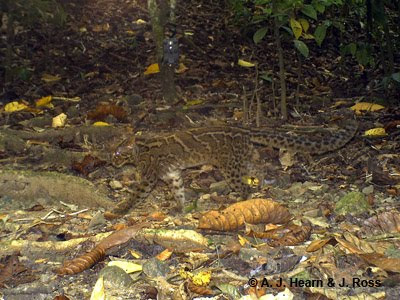Friday, October 23, 2009
 Bears, elephants, and thieves
Bears, elephants, and thieves
9:17 AM | Posted by
Andy Hearn |
Edit Post
Camera trappers around the world will be familiar with the feeling of nervous anticipation each and every time they go to check a camera trap in the field. Thoughts race through your head as you reach the final bend in the trail before setting sight on the camera trap.... are the batteries still OK, has it been damaged, is it even still there?
And so it was this week when we arrived to check camera site 22, situated uncomfortably close to the main road along Tabin’s western border, which is frequented by plantation workers and the occasional poacher alike. To our dismay both cameras were gone, presumably stolen by poachers. Pieces of plastic from one of the cameras littered the floor, but otherwise there was no trace of the cameras and the invaluable data they contained. The tree that one of the cameras was attached to had been cut down with a parang (local machete).
Poaching – Borneo style. The main quarry targeted are Samba deer, muntjac, and bearded pig. Thankfully the number of poachers using the core road appears low, but the threat remains.
The loss of a single pair of cameras, although frustrating, should not have too detrimental an affect on our survey, but the loss of further cameras could be a real problem. We also recently photographed poachers on the main core road (photo above) that runs through the centre of Tabin. An individual can be seen standing in the back of a Toyota Hylux, spotlight in hand. Thankfully these guys left the cameras alone.
Borneo’s wildlife also give us sleepless nights when it comes to causing havoc with the cameras. The ubiquitous elephants are a frequent thorn in our side, typically knocking cameras over, but also on occasion ripping them out of the ground and walking away with them. Over the years we’ve developed a number of anti elephant-damage measures, of varying success, but thankfully Tabin’s elephants have been relatively kind so far. In a previous survey of Malua Forest Reserve the elephants were particularly aggressive, frequently knocking over, and occasionally “stealing” cameras!
One of Tabin’s elephants; we arrived 20 mins after this photo was taken to check the camera.
And now a new contender for the No.1 nuisance animal may be emerging – the sun bear. In the past we’ve had little trouble from the world’s smallest bear species, but just recently a bear took a dislike to two of our cameras and ripped them off their respective trees, resulting in a large hole in the casings, and then preceded to chew on the box, despite the metal spikes that jut out from the case at multiple angles. He returned days later to finish off what he started and to destroy the remaining camera. Let’s just hope that this is a one-off, and that he was just having a bad day.
The sun bear spots the camera and immediately makes a bee-line for it.
Bear-cam….. Good night Vienna! The final photographs from the camera as it is mauled by the irate sun bear.
The bear returns days later and has his fun with the broken camera before taking-out the remaining camera.
The cameras didn’t stand a chance! These two will likely be winging their way to the new clouded leopard exhibit at Point Defiance Zoo, as part of the Clouded leopard Project’s (CLP) education display.
NEWS FLASH.
Since writing this blog it seems as though the bear-trashed cameras may in fact pull through, despite both being full of water for several days. The exposure seems to be affected, but they may be fine during the night and as a back-up? Sorry Karen (CLP), but we have many more broken cameras!
Monday, October 19, 2009
 First wild cat photos from Tabin!
First wild cat photos from Tabin!
4:38 PM | Posted by
Andy Hearn |
Edit Post
After two months of seriously tough work setting up the first block of camera traps we are delighted to inform you that we are beginning to see results, including photos of leopard cats, marbled cats and clouded leopards!
As expected, the first wild cat photograph that we captured at Tabin was of a leopard cat. Since then we have captured a further 19 Leopard cats on camera, mainly along the core road, but also along some of the abandoned logging roads and some of our freshly cut trails.
Leopard cat photographed on the core road at 7:25 pm.
To date we have captured five independent (i.e. taken at different times) photographs of clouded leopards, two from the core road that runs through the reserve, two from an old logging road (jalan Raya bagus). Unfortunately, on all occasions only one camera out of the pair photographed the cat, meaning that we have only either left or right sided photos – not both – as we desperately need in order to identify individual animals unambiguously. Nevertheless, from comparing only left sides we can tell that that we have at least three different animals – all males.
Clouded leopard Male 2 or Mr Fish (Jo thinks he has a fish shape marking or cloud, on his side)
Surprisingly, we have captured four independent photos of two individual marbled cats, both female. I say surprisingly because it is very rare to get this species on camera. These two were photographed at a single site along a trail that we created from new. On all but one occasion the marbled cats were walking directly along the path that we had previously swept clean, leading us to tentatively assume that our trail cutting and sweeping have encouraged these cats to use the trail.
A female marbled cat photographed along a “purpose-built” trail.
This is a great start to the survey, let’s hope that the good luck continues!
Subscribe to:
Posts (Atom)









